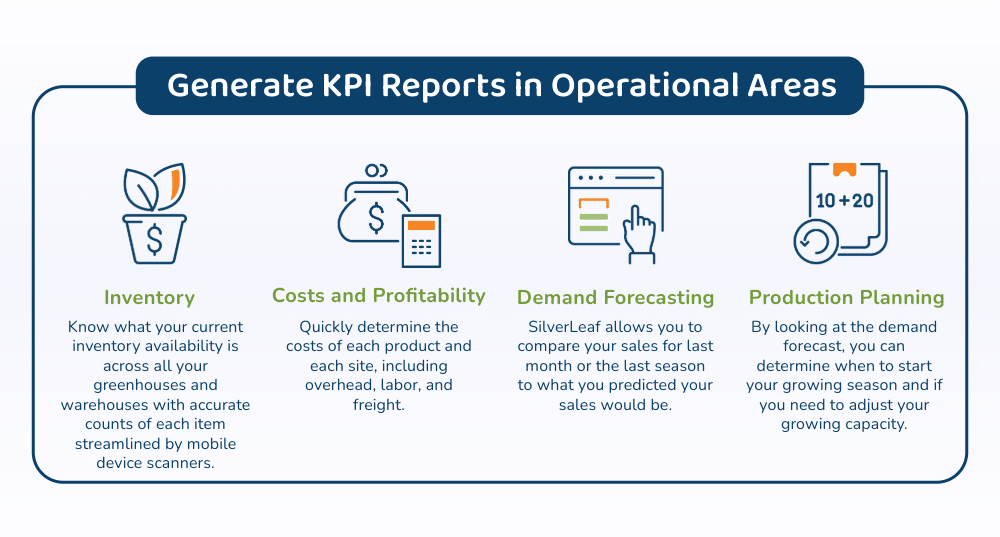Optimizing Greenhouse Operations with Data-Driven Insights
Learn how data-driven insights can optimize greenhouse operations, enhance efficiency, and boost crop yield with smart analytics and technology.
Table of Content
For greenhouse growers, the window of opportunity is highly variable. The weather, pests, soil conditions, water availability, supply chain partners, customer demand, and workforce resources all impact how much you can grow and how much you can sell.
That window is also short, particularly in northern climates. Everyone wants to buy flowers, plants, shrubs, and trees in the spring so they can enjoy them throughout the summer and fall. Inventory you don’t sell simply dies on the shelf. And if you miss out on an order from a big box retailer, you have to wait until next season to win the business back.
Given this window of opportunity, greenhouse operators must have access to real-time, accurate data. Only then will they have time to react as they plan for next season and start growing their products.
Owners who rely on spreadsheets to manage their business find that data simply does not flow in fast enough. By the time reports arrive, the data has probably changed. There’s simply no way for sales, production, and warehouse teams to sync their efforts to ensure they fulfill all customer orders on time and don’t miss any sales opportunities.
The key to providing real-time, accurate data to end-users across a greenhouse operation is to utilize an ERP platform running in the cloud and tailored for the horticulture industry. This allows for centralizing all financial and operational data within a single database. And with all data from sales, production, and the warehouse stored in one place, everyone sees the same information.
Just as importantly, users can access the workflows customized for greenhouse operators via the cloud. This includes working in the office, on the road, at a customer site, or using a mobile device in a greenhouse or out in the field. Instead of hand-written notes someone needs to key into a spreadsheet on a single user’s desktop, all that data automatically flows into the ERP platform.
Essentially, everyone knows what’s going on across the entire operation. They can quickly make decisions when glitches occur, such as cuttings that arrive frozen, a customer failing to follow through on a pre-booked order, or the wrong type of flower arriving from a supply chain partner.
To take on the challenge of providing real-time, accurate data across their operations, many greenhouse growers have turned to SilverLeaf from Velosio. Built with workflows for the horticulture industry, SilverLeaf runs on the Microsoft Dynamics 365 Business Central ERP platform, which provides comprehensive financial management capabilities.
The solution also integrates easily with the Microsoft Power Platform, which allows greenhouses to further customize their workflows. Another key integration is Microsoft Power BI, which allows managers and front-line personnel to generate key performance indicator (KPI) reports in all operational areas:
Your sales management capabilities will also improve. The sales team can compare pre-booked customer demand to actual sales and identify what’s trending for the next season. These inputs will also allow the production team to adjust their plan as to what they will produce to meet the customer demand in both quantities and types of flowers, plants, shrubs, and trees. Sales can also efficiently manage customer requirements for tags, shipping, and racking.

With real-time reporting taking place across inventory, costs, customer demand, production, and sales activity, using SilverLeaf creates synergistic benefits. With all the reports feeding into each other, the entire operation can act as a cohesive unit.
For example, if the sales team receives an unexpected large order from a key customer, they will immediately know if there’s enough inventory. They don’t have to chase down the warehouse managers who might need to send someone out to the greenhouse to get an accurate count.
If the production team suddenly finds they have too many items of a particular flower or plant, SilverLeaf automatically notifies the sales team. This makes it possible to look for a customer who might want that extra inventory.
When production issues occur, such as a large quantity of damaged cuttings, SilverLeaf workflows notify the procurement team. The warehouse team doesn’t need to worry about sending an email. The procurement team knows right away and can start working with the supply chain partner or an alternative source.
To learn more about SilverLeaf running on Dynamics 365 Business Central—and how it helps you generate all the KPIs you need to run your business more efficiently—check out Leveraging SilverLeaf and Dynamics 365 Business Central Features for Growers webinar. Velosio horticulture industry experts will take you through report screenshots that allow you to pinpoint sales, production, inventory, and supply chain activity.
You can also contact Velosio to arrange for a SilverLeaf demo and talk to one of our technology experts.
We will be glad to show you how SilverLeaf lets you drill down into reports to uncover insights that allow you to adjust your operations to function more efficiently and capitalize on customer demand.
Talk to us about how Velosio can help you realize business value faster with end-to-end solutions and cloud services.